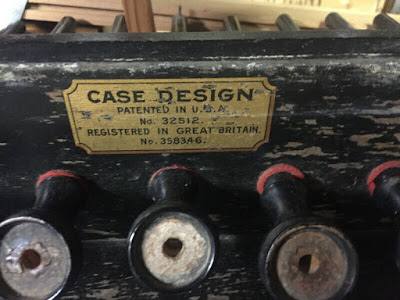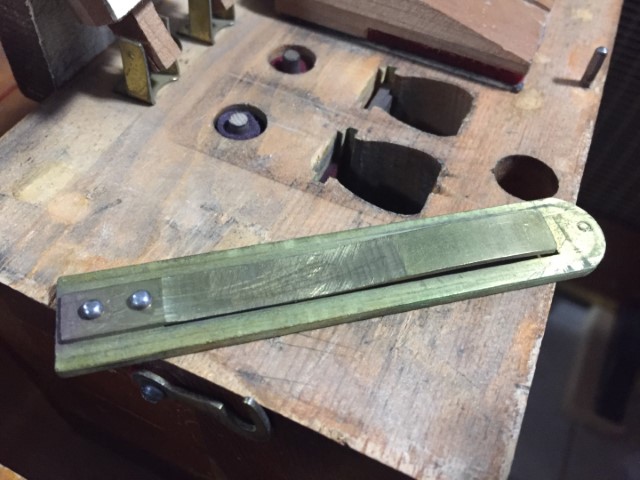Farrand Organ Action
This disembodied organ action was listed for many months in Banff, Alberta, Canada and was destined to go to the landfill. The owner acquired the action from someone who had removed the case about 40 years ago (around 1980) to make it into a bookshelf. Attempts were made by the owner to find the current whereabouts of the case, but the fate of the case was unknown.
 |
| It appears this was originally sold in Great Britain |
Description from the seller's son:
My father used to play the organ occasionally but it has sat relatively unplayed now for probably a good 30 years. It has been covered up in a relatively cool basement. It played very well and loud last time I heard my father play it. The fellow who had the case does not have it anymore, and has no idea where it went.
The action has the Farrand company logo on it. Farrand is an American organ brand. The organs were made in Detroit, Michigan. Farrand & Votey made both reed organs and pipe organs between 1887 and 1897. The company dissolved in 1897 and two separate companies were formed. Votey made pipe organs and Farrand made reed organs. The Farrand Organ Co. name was used on reed organs from 1897 until at least 1908. I have no serial number from the case that is now lost, so this is all I have to go by for now to date the organ. If I'm lucky I'll find a date written inside the action somehwere.
I transported the organ in two pieces in late September, 2020. The action in the hatch and the bellows on the roof rack.
Upon arriving home with it, I was pleasantly surprised to find it was in reasonably good working order, other than needing a good reed cleaning and tuning. The bellows/wind system condition is similar to my Doherty (some leaks, but playable). One difference is the Farrand reservoir is covered with a stiff vinyl-coated cloth, which makes playing with expression feel more difficult/less precise.
At home the air test time was initially around 12 seconds. Then 6-8 seconds in winter. I define an "air test" as follows: Time holding a single note near middle C, with one 8' stop open, after the reservoir has been fully exhausted and pedaling stops, with the organ fully assembled in normal operating mode and no air intakes taped off.
I was also happy to find I now had the opportunity to play on something with "more reeds", formerly the stuff of legends for me. 15-Stops seemed modest, so I didn't expect much different than my 13-Stop Doherty (2.5 rows of reeds plus sub bass). However, a close investigation at home found the following reed sets tucked away in the action:
Bass//Treble: 16'SB, 8', 4', 2', 2'c // 16', 8', 8', 4', 2'
c=celeste reed sets (tremolo reeds)
The Vox Celeste stop for the 8' opens a mute to empty reed cells above the reed cells containing the 8' reeds below. These creates a flute-like tone when this stop is activated.
The action has 15 stops, so I hoped for something with perhaps 3 rows of reeds or so, plus the sub bass. I was surprised to find 290 total reeds, equivalent to 4.5 rows of reeds plus sub bass for the 5-octave keyboard of 61 notes.
It appears the original “Vox Humana” fan card is on the organ, or it was at one time replaced with a "Farrand" branded fan card.
 |
| I'm guessing this belong on Stop #6 for the 2x2' celeste in the bass |
 |
| Sub Bass Reed: 0.099" thick x 0.673" width. Rivets are smooth, rounded design. |
 |
| Some of the 8' reeds from the Vox Celeste bank |
 |
| The reeds show evidence of past filing/tunings/scrapings. Rivets are cross-hatch design/pattern. |
 |
| Underside of a reed |
 |
| 8' reed dimensions: 0.088" x 0.418" width |
If I can get it tuned properly, I am contemplating trying my hand at busking with the organ next summer in a concrete pedestrian underpass with nice acoustics, as it is reasonably portable. Without the case, it provides a fun opportunity to show the inner workings of a mechanical wonder of the past -- one that has endured far longer than most electronic keyboards of today are expected to survive.
I can fit the action in the hatch of my compact car and the bellows on the roof rack, acting as a kind-of-portable organ for now, at least until I eventually find an actual portable that would look nicer. And maybe for the long-term, instead of a portable -- there are no portables to my knowledge with this many reed sets! Perhaps some day I'll find a Farrand case to place it in, or just part it out. Not sure.
It has a different tone from the Doherty, especially the 8' Celeste (more "flute?" like). The sub bass has less volume and "grunt". And of course, it has a brighter sound without the case. The 2' treble is open to the air without a swell shade -- it's almost painfully piercing. I plan to build a cardboard or wood box to place over it, and perhaps someday rig up my own version of Scribner Qualifying Tubes, given the extra space behind the action without the case interfering (playing/acquiring an organ with actual Scribner Tubes remains on my bucket list).
The 2' celeste reeds are agonizingly out of tune, so those have to wait for now. The Doherty is still my favorite by far, but I'm having fun playing around with the multitude of reed sets in the Farrand. I plan to clean and tune the reeds next.
On average the pitch generally seems to be around A438, or about 5 to 10 cents flat of A440. This may change after cleaning the reeds. The vast majority of the notes punched onto the reeds match the keys that activate them, suggesting the reeds were not moved over one cell to bring it closer to A440. The reeds show much evidence of tuning scraping in the past. I'm wondering how much the reeds were modified from their original tuning, if they may be damaged due to excessive filing and if this will make tuning it difficult.
My plan is to tune it to A440, since it is already very close to this. Most reeds are about 5 to 20 cents flat of A440. A few are 5 to 10 cents sharp of A440. I'm not sure what the original tuning was.
I built this manometer to aid with tuning, so that I can target 2.0 to 2.5 inches vacuum. This will help create a consistent vacuum pressure, since the pitch varies with different vacuum pressures.
 |
| Manometer connected where the Vox Humana Fan was removed |
An initial spot check on eight random keys found the following average touchweights:
In February 2021 I discovered the B-flat/A# sub bass reed was not sounding. Close examination revealed a crack in the reed tongue. To my knowledge there is no practical way to repair this. I will have to source a replacement reed if I plan to play this organ as a practice instrument.
There are also some other anomalies to investigate further:
- A buzzing tone in G#4 of the 8ft rank
- A cypher sounding in the 2ft rank, when only the 8 ft rank is open, and only when pressing B4 and F5.
- Several reeds are silent, likely needing to be cleaned. And hopefully not cracked.
- One reed is extra loud.
- One reed sounds like it's hitting the frame.













Comments
Post a Comment